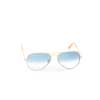Ray-Ban Steel Frames: A Classic of the Genre
You can (and sometimes should) invent all sorts of innovations: plastic, aluminum, titaniumЕ But nothing will ever replace one metal in eyewear frame making Ч good old steel.
If you agree with this, or even if you don't, we suggest you keep reading!
A Drop of Theory
Steel is an alloy of iron and carbon (which adds strength) or other elements.
As for eyewear production, stainless steel is most commonly used Ч alloyed (that is, with added impurities) and resistant to changes in extreme environments.
In 1913, through experiments, Harry Brearley developed this type of steel: he discovered that alloys with high chromium content were highly resistant to acid corrosion.
It was the dawn of the steel era.
Today, thereТs even a European standard, EN 10020, which defines stainless steels as alloys containing at least 10.5% chromium.
Steel for Eyewear!
As for the use of steel in optics, it has many favorable properties: long-lasting durability, strength, hygiene (due to the absence of cracks and cavities where bacteria usually thrive), easy cleaning (water is enough), and resistance to various types of corrosion.
In terms of consumer benefits of steel frames, they offer flexibility (a worthy response to falling or getting caught) and chemical resistance (no to corrosive elements found in sweat, rain, and snow, especially in urban environments =).
Regarding the downsides of steel frames for wearers Ч there simply arenТt any. Well, except that they are a bit heavier than their plastic or carbon counterparts. But the main thing is, they fit like a charm!
Currently, Ray-Ban offers numerous models with steel frames. And to be honest, it would be a shame not to try them on, or at least give them a test run!





